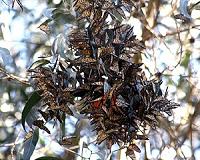| . |  |
. |
Washington (AFP) Feb 10, 2010 Conservationists appealed Wednesday for an end to the commercial tiger trade, warning that demand in China, Southeast Asia -- but also the United States -- was threatening the big cats with extinction. Environmental campaigners see 2010 as crucial to spread their message as East Asian nations celebrate the Year of the Tiger and Russia prepares to hold a summit on tiger conservation in September in Vladivostok. Only some 3,200 tigers remain in the wild, nearly half of them in India, down from 100,000 worldwide a century ago due to burgeoning human populations and a demand in China, Vietnam and Laos for tiger parts in folk medicine. But environmental campaigners said the problem was not just in Asia. They worried about the United States, where more than 5,000 tigers are believed to be in private hands as backyard pets or roadside zoo attractions. Crawford Allan, director of North America operations at the conservation program Traffic, said an investigation had found tiger-breeding farms akin to puppy mills help meet the demand. With tigers often too dangerous to handle after six months old, they risk exploitation after they outgrow their usefulness, Allan said. He voiced alarm that some US restaurants have sold tiger meat as an exotic dish. "The US needs to take action," Allan told reporters on a conference call. "It is virtually impossible in some states to know where tigers are, how many there are and if they're being sucked into a trafficking black hole." While 26 states ban private ownership of tigers, nine states -- including North Carolina, Ohio, South Carolina and Wisconsin -- have no regulations at all, he said. The highest number of captive tigers are found in Texas, which has regulations on tiger ownership but rarely enforces them, according to Allan. Conservationists have largely applauded the Chinese government's efforts to stamp out the tiger trade, but they warned that a growing private industry of tiger farms in Asia was putting new pressure on the endangered species. Chinese authorities said this week that the country had nearly 6,000 tigers in captivity and could breed 1,000 more every year as part of an effort to increase the animals' population. But tiger supporters warn that more animals are being bred in underground farms and have vowed to fight any push to legalize them. "This is an extremely dangerous phenomenon for the survival of wild tigers," said Keshav Varma, project director of the World Bank's Global Tiger Initiative. "Once this becomes a business, it can have a perverse effect on markets by stimulating and sustaining demand." He said a rise of the middle class in China and other nations was also leading to new demand for tiger parts -- not just for local medicines or wines, but also for tiger skins used as ornamental gifts. Huang Lixin, president of the American College of Traditional Chinese Medicine in San Francisco, said doctors would campaign throughout the year to warn of the risks to the animal population and distance themselves from the use of tiger parts. "I think the Year of the Tiger is a tremendous opportunity for us to reach the Chinese public as well as the world Chinese community," Huang said.
Share This Article With Planet Earth
Related Links Darwin Today At TerraDaily.com
 Migrating Insects Fly In The Fast Lane
Migrating Insects Fly In The Fast LaneLondon, UK (SPX) Feb 10, 2010 A study published in Science, by researchers at Rothamsted Research (an institute of the BBSRC), the Met Office, the Natural Resources Institute, and the Universities of Exeter, Greenwich and York, sheds new light on the flight behaviours that enable insects to undertake long-distance migrations, and highlights the remarkable abilities of these insect migrants. Many insects avoid cold Brit ... read more |
|
| The content herein, unless otherwise known to be public domain, are Copyright 1995-2010 - SpaceDaily. AFP and UPI Wire Stories are copyright Agence France-Presse and United Press International. ESA Portal Reports are copyright European Space Agency. All NASA sourced material is public domain. Additional copyrights may apply in whole or part to other bona fide parties. Advertising does not imply endorsement,agreement or approval of any opinions, statements or information provided by SpaceDaily on any Web page published or hosted by SpaceDaily. Privacy Statement |